Themed collection In memory of Chris Abell

Coenzyme biosynthesis : enzyme mechanism, structure and inhibition
Key steps in vitamin biosynthesis: insights from mechanistic and structural studies.
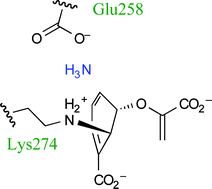
Nat. Prod. Rep., 2007,24, 1009-1026
https://doi.org/10.1039/B703108B
Biosynthesis of pantothenate
A comprehensive review of recent developments in the enzymology of pantothenate biosynthesis, incorporating an historical perspective.

Nat. Prod. Rep., 2004,21, 695-721
https://doi.org/10.1039/B316419P
The use of FTICR-MS to detect chemical tags from a combinatorial library
Analyst, 2002,127, 1399-1406
https://doi.org/10.1039/B203957P
Construction of core–shell microcapsules via focused surface acoustic wave microfluidics
A method to produce core–shell microcapsules with a solid core or microdroplet core via FSAW microfluidics is demonstrated.
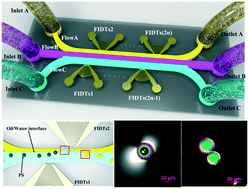
Lab Chip, 2020,20, 3104-3108
https://doi.org/10.1039/D0LC00123F
Bioinspired hydrogel microfibres colour-encoded with colloidal crystals
The integration of microfluidic spinning and colloidal crystal microdots enable the colour-encoded hydrogel microfibres with facile and flexible manipulation of the encoding.
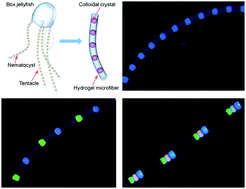
Mater. Horiz., 2019,6, 1938-1943
https://doi.org/10.1039/C9MH00528E
Cucurbit[7]uril-based high-performance catalytic microreactors
Fabrication of cucurbit[n]uril-based catalytic microreactors through the immobilisation of metallic nanoparticles onto microchannels.
![Graphical abstract: Cucurbit[7]uril-based high-performance catalytic microreactors](/en/Image/Get?imageInfo.ImageType=GA&imageInfo.ImageIdentifier.ManuscriptID=C8NR02900H&imageInfo.ImageIdentifier.Year=2018)
Nanoscale, 2018,10, 14835-14839
https://doi.org/10.1039/C8NR02900H
Structural insights into the EthR–DNA interaction using native mass spectrometry
The interaction between Mycobacterium tuberculosis EthR and its operator DNA has been studied by native mass spectrometry, revealing an interesting stoichiometry.

Chem. Commun., 2017,53, 3527-3530
https://doi.org/10.1039/C7CC00804J
Surface-immobilised micelles via cucurbit[8]uril-rotaxanes for solvent-induced burst release
Surface-immobilised micelles via CB[8]-rotaxane host–guest recognition undergoes ‘burst’ release of cargo upon exposure to organic solvents.
![Graphical abstract: Surface-immobilised micelles via cucurbit[8]uril-rotaxanes for solvent-induced burst release](/en/Image/Get?imageInfo.ImageType=GA&imageInfo.ImageIdentifier.ManuscriptID=C5CC00121H&imageInfo.ImageIdentifier.Year=2015)
Chem. Commun., 2015,51, 4858-4860
https://doi.org/10.1039/C5CC00121H
Supramolecular colloidosomes: fabrication, characterisation and triggered release of cargo
Supramolecular colloidosomes are self-assembled at the interface of microfluidic droplets via a cucurbit[8]uril host–guest complex, allowing for triggered release of aqueous cargo.

Chem. Commun., 2014,50, 7048-7051
https://doi.org/10.1039/C4CC01479K
Targeting a c-MYC G-quadruplex DNA with a fragment library
A fragment library was screened against the human c-MYC promoter G-quadruplex. Ten fragment hits had a significant concordance between a biophysical assay, in silico modelling and c-MYC expression inhibition.
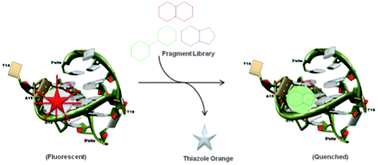
Chem. Commun., 2014,50, 1704-1707
https://doi.org/10.1039/C3CC48390H
Surface-induced droplet fusion in microfluidic devices
Surface energy patterning in microfluidic channels provides a new tool for droplet fusion that does not require active elements nor accurate synchronization.

Lab Chip, 2007,7, 984-986
https://doi.org/10.1039/B708091C
Quantitative detection of protein expression in single cells using droplet microfluidics
We demonstrate that single cells can be controllably compartmentalized within aqueous microdroplets. Using such an approach we perform high-throughput screening by detecting the expression of a fluorescent protein in individual cells with simultaneous measurement of droplet size, fluorescence and cell occupancy.
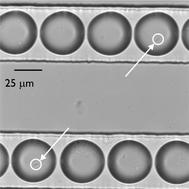
Chem. Commun., 2007, 1218-1220
https://doi.org/10.1039/B618570C
Building three-dimensional nanostructures with active enzymes by surface templated layer-by-layer assembly
The first controlled fabrication of three-dimensional nanostructures with functional enzymes by templated layer-by-layer assembly of avidin and biotinylated horseradish peroxidase on micro-contact printing patterned surfaces is presented.
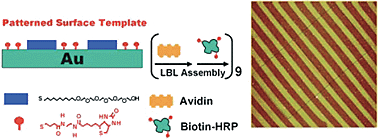
Chem. Commun., 2006, 1721-1723
https://doi.org/10.1039/B517557G
Fluorescence resonance energy transfer between a quantum dot donor and a dye acceptor attached to DNA
Direct coupling of a dye-labelled DNA (acceptor) to a quantum dot (QD) donor significantly reduces the donor–acceptor distance and improves the FRET efficiency in quantum dot bioconjugates.

Chem. Commun., 2005, 4807-4809
https://doi.org/10.1039/B508911E
Rational design of new bifunctional inhibitors of type II dehydroquinase
New selective inhibitors of type II dehydroquinase were rationally designed to explore extra binding interactions, resulting in increased potency.
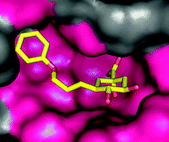
Org. Biomol. Chem., 2005,3, 3102-3104
https://doi.org/10.1039/B507156A
Inhibition studies on salicylate synthase
Chorismate and isochorismate analogues were designed and tested as inhibitors of Yersinia enterocolitica salicylate synthase.
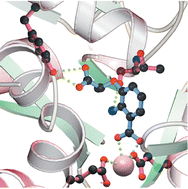
Org. Biomol. Chem., 2005,3, 1825-1827
https://doi.org/10.1039/B503800F
Enzymic synthesis of 3-[3-13C]dehydroquinic acid
3-[13C]Dehydroquinic acid has been prepared from commercially available D-5-[13C]fructose over four enzyme catalysed steps.
![Graphical abstract: Enzymic synthesis of 3-[3-13C]dehydroquinic acid](/en/Image/Get?imageInfo.ImageType=GA&imageInfo.ImageIdentifier.ManuscriptID=B309666A&imageInfo.ImageIdentifier.Year=2003)
Org. Biomol. Chem., 2003,1, 3271-3273
https://doi.org/10.1039/B309666A
Rapid screening by MALDI-TOF mass spectrometry to probe binding specificity at enzyme active sites
The binding affinity of E. coli aspartate decarboxylase has been probed using MALDI-TOF spectrometry after incubation of the enzyme with a range of potential ligands in the presence of NaCNBH3. This has highighted key structural features which will aid design of potential inhibitors.
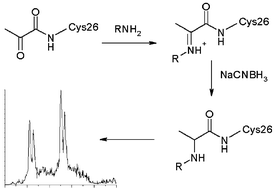
Chem. Commun., 2003, 2416-2417
https://doi.org/10.1039/B308182F
Systematic manipulation of surface chemical reaction on the nanoscale: a novel approach for constructing three-dimensional nanostructures
Nanoscale patches, created by nanografting a
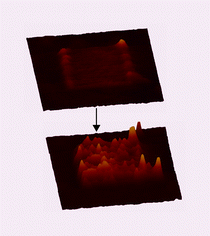
Chem. Commun., 2003, 474-475
https://doi.org/10.1039/B211906D
Vinyl fluoride as an isoelectronic replacement for an enolate anion: Inhibition of type II dehydroquinases
Chem. Commun., 2002, 1886-1887
https://doi.org/10.1039/B205105M
Identification of Tyr58 as the proton donor in the aspartate-α-decarboxylase reaction
Chem. Commun., 2001, 1760-1761
https://doi.org/10.1039/B106090M
Aqueous interfacial gels assembled from small molecule supramolecular polymers
The successful self-assembly of a stimuli-responsive aqueous supramolecular hyperbranched polymer from small molecules and the macrocyclic host cucurbit[8]uril (CB[8]) is reported. This self-healing supramolecular network can act as a soft matter barrier at liquid–liquid interfaces.
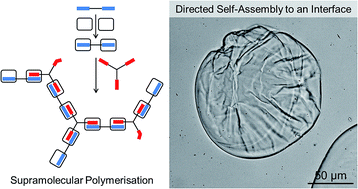
Chem. Sci., 2017,8, 1350-1355
https://doi.org/10.1039/C6SC04103E
Specific inhibition of CK2α from an anchor outside the active site
CAM4066, a specific CK2α kinase inhibitor, is anchored in the cryptic αD pocket outside the active site and inserts a “warhead” into the active site, blocking ATP binding and thereby inhibiting the kinase.

Chem. Sci., 2016,7, 6839-6845
https://doi.org/10.1039/C6SC02335E
Supramolecular hydrogel microcapsules via cucurbit[8]uril host–guest interactions with triggered and UV-controlled molecular permeability
Host–guest assembly at the interface of microfluidic droplets offers a versatile strategy to construct supramolecular hydrogel microcapsules with “smart” cargo release.
![Graphical abstract: Supramolecular hydrogel microcapsules via cucurbit[8]uril host–guest interactions with triggered and UV-controlled molecular permeability](/en/Image/Get?imageInfo.ImageType=GA&imageInfo.ImageIdentifier.ManuscriptID=C5SC01440A&imageInfo.ImageIdentifier.Year=2015)
Chem. Sci., 2015,6, 4929-4933
https://doi.org/10.1039/C5SC01440A
Fragment screening against the thiamine pyrophosphate riboswitchthiM
The development of a method to identify novel fragment ligands for the TPP riboswitch thiM is described.
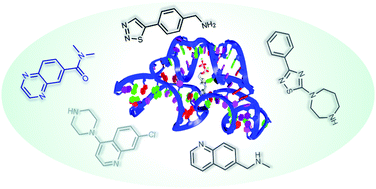
Chem. Sci., 2011,2, 157-165
https://doi.org/10.1039/C0SC00406E
Dual-responsive supramolecular colloidal microcapsules from cucurbit[8]uril molecular recognition in microfluidic droplets
Thermal and light dual-responsive supramolecular colloidal microcapsules have been successfully prepared by combining cucurbit[8]uril-based host–guest recognition with the self-assembly of colloidal particles within microfluidic droplets.
![Graphical abstract: Dual-responsive supramolecular colloidal microcapsules from cucurbit[8]uril molecular recognition in microfluidic droplets](/en/Image/Get?imageInfo.ImageType=GA&imageInfo.ImageIdentifier.ManuscriptID=C6PY01171C&imageInfo.ImageIdentifier.Year=2016)
Polym. Chem., 2016,7, 5996-6002
https://doi.org/10.1039/C6PY01171C
A fragment merging approach towards the development of small molecule inhibitors of Mycobacterium tuberculosis EthR for use as ethionamide boosters
With the ever-increasing instances of resistance to frontline TB drugs there is the need to develop novel strategies to fight the worldwide TB epidemic.
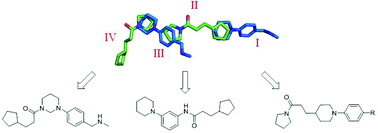
Org. Biomol. Chem., 2016,14, 2318-2326
https://doi.org/10.1039/C5OB02630J
Probing riboswitch–ligand interactions using thiamine pyrophosphate analogues
The binding of thiamine pyrophosphate (TPP) to the thiM riboswitch has been systematically explored by testing a range of TPP analogues in which the aminopyrimidine ring, the central thiazolium ring, and the pyrophosphate tail are each replaced in turn by similar structures.
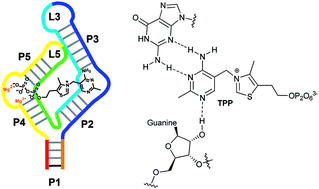
Org. Biomol. Chem., 2012,10, 5924-5931
https://doi.org/10.1039/C2OB07116A
Controlling the contents of microdroplets by exploiting the permeability of PDMS
The protein crystallization and gene expression in vivo can be controlled by transporting small molecules through PDMS membrane to manipulate the chemical environment of microdroplets.

Lab Chip, 2011,11, 1132-1137
https://doi.org/10.1039/C0LC00615G
Microdroplet fabrication of silver–agarose nanocomposite beads for SERS optical accumulation
Highly uniform Ag–agarose microbeads prepared using a flow-focusing microfluidic device can trap and concentrate analytes increasing the analytical sensitivity of SERS.
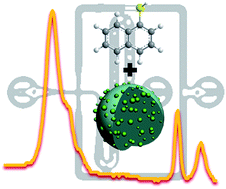
Soft Matter, 2011,7, 1321-1325
https://doi.org/10.1039/C0SM00601G
A chelating dendritic ligand capped quantum dot : preparation, surface passivation , bioconjugation and specific DNA detection
A chelating dendritic ligand capped stable, compact, water-soluble quantum dot allows for effective surface defect passivation and sensitive DNA detection.
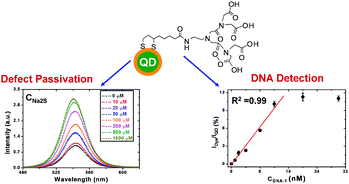
Nanoscale, 2011,3, 201-211
https://doi.org/10.1039/C0NR00462F
Inhibition of chorismate -utilising enzymes by 2-amino-4-carboxypyridine and 4-carboxypyridone and 5-carboxypyridone analogues
A number of 2-amino-4-carboxypyridine, 4- and 5-carboxypyridone-based compounds were prepared. Several compounds proved to be low micromolar inhibitors when screened against three members of the chorismate-utilising enzyme family.
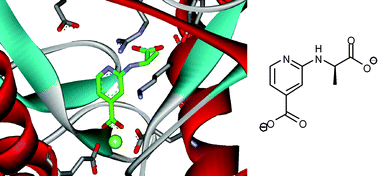
Org. Biomol. Chem., 2010,8, 3534-3542
https://doi.org/10.1039/C004062B
Hydrophilic PDMS microchannels for high-throughput formation of oil-in-water microdroplets and water -in-oil-in-water double emulsions
We developed an extremely convenient, largely automated surface modification technique for the production of long-term stable hydrophilic channel walls inside PDMS-based microfluidic devices and applied it successfully for the high-throughput generation of highly monodisperse o/w droplets and w/o/w double emulsions.
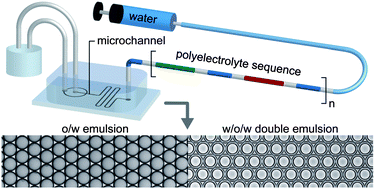
Lab Chip, 2010,10, 1814-1819
https://doi.org/10.1039/C004046K
A double droplet trap system for studying mass transport across a droplet-droplet interface
Here we present the design, fabrication and operation of a microfluidic device to trap droplets in a large array of droplet pairs in a controlled manner.
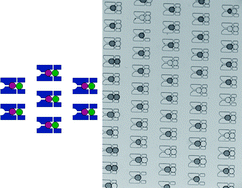
Lab Chip, 2010,10, 1281-1285
https://doi.org/10.1039/B925133B
Vancomycin dimer formation between analogues of bacterial peptidoglycan surfaces probed by force spectroscopy
Force spectroscopy was used to investigate the rupture of interfacial vancomycin dimer complexes formed between pairs of vancomycin molecules when bound to model bacterial cell-wall surfaces.

Org. Biomol. Chem., 2010,8, 1142-1148
https://doi.org/10.1039/B919347B
Simultaneous measurement of reactions in microdroplets filled by concentration gradients
We demonstrate the integration of on-chip dilution with droplet formation, leading to parallel streams of microdroplets which allow the simultaneous measurements of enzymatic activity at different concentrations of substrate.
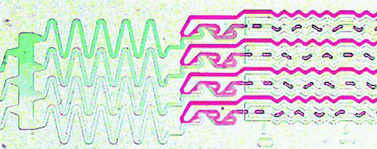
Lab Chip, 2009,9, 1707-1713
https://doi.org/10.1039/B821021G
An integrated cell culture lab on a chip: modular microdevices for cultivation of mammalian cells and delivery into microfluidic microdroplets
A modular system of microfluidic PDMS devices was designed to incorporate the steps necessary for cell biological assays based on mammalian tissue culture ‘on-chip’. The design allows cultivation of cells for extended periods of time in combination with assessment of transfection rates and successive encapsulation of CHO-K1 cells achieved on-chip.

Lab Chip, 2009,9, 1576-1582
https://doi.org/10.1039/B821695A
Synthesis and evaluation of 2,5-dihydrochorismate analogues as inhibitors of the chorismate-utilising enzymes
A library of 2,5-dihydrochorismate analogues were designed as inhibitors of the chorismate-utilising enzymes anthranilate synthase, isochorismate synthase, salicylate synthase and 4-amino-4-deoxychorismate synthase. The compounds, synthesised from shikimic acid, showed differential enzyme inhibition.

Org. Biomol. Chem., 2009,7, 2421-2429
https://doi.org/10.1039/B901694E
Static microdroplet arrays: a microfluidic device for droplet trapping, incubation and release for enzymatic and cell-based assays
We describe the design, fabrication and use of a single-layered poly(dimethylsiloxane) microfluidic structure for the entrapment and release of microdroplets in an array format controlled entirely by liquid flow.

Lab Chip, 2009,9, 692-698
https://doi.org/10.1039/B813709A
The design and synthesis of inhibitors of pantothenate synthetase
Ten analogues of pantoyl adenylate, a reaction intermediate of the reaction catalysed by pantothenate synthetase, were synthesised as potential inhibitors of the enzyme. Analogues in which the phosphodiester was replaced by a sulfamoyl group were more potent than those in which it was replaced by an ester.
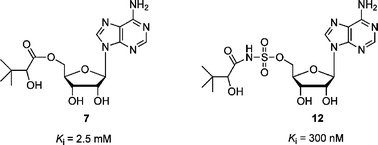
Org. Biomol. Chem., 2006,4, 3598-3610
https://doi.org/10.1039/B609482A
Design and synthesis of aromatic inhibitors of anthranilate synthase
Docking of aromatic chorismate analogue containing a C-4 hydroxymethyl substituent into the active site of Serratia marcescens anthranilate synthase.
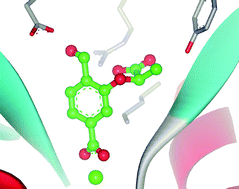
Org. Biomol. Chem., 2005,3, 3629-3635
https://doi.org/10.1039/B510633H
Design and synthesis of aromatic inhibitors of anthranilate synthase
Aromatic chorismate analogues were synthesised and tested against anthranilate synthase. The most potent compound exhibited a KI of 3 µM.
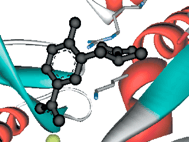
Org. Biomol. Chem., 2005,3, 2271-2281
https://doi.org/10.1039/B503802B
(1R,4S,5R)-3-Fluoro-1,4,5-trihydroxy-2-cyclohexene-1-carboxylic acid : the fluoro analogue of the enolate intermediate in the reaction catalyzed by type II dehydroquinases
The fluoro analogue of the enolate intermediate in the reaction catalyzed by type II dehydroquinases has been prepared and has been shown to be the most potent inhibitor reported to date of the type II enzyme from Mycobacterium tuberculosis.

Org. Biomol. Chem., 2004,2, 1592-1596
https://doi.org/10.1039/B404535A
A novel phase-switching protecting group for multi-step parallel solution phase synthesis
A novel protecting group that incorporates functionalities to facilitate compound purification by enabling solid-phase extraction in either an irreversible, or pH dependent reversible manner is presented, and its use in parallel synthesis is exemplified.
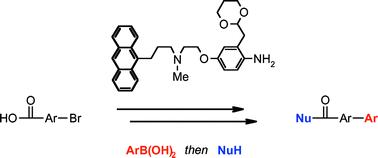
Org. Biomol. Chem., 2004,2, 989-998
https://doi.org/10.1039/B400110A
Polymer-assisted solution phase synthesis of the antihyperglycemic agent Rosiglitazone (Avandia™)
The preparation of the antihyperglycemic agent Rosiglitazone (Avandia™) in high purity by a multi-step polymer-assisted solution phase synthesis requiring no conventional chromatography is reported.
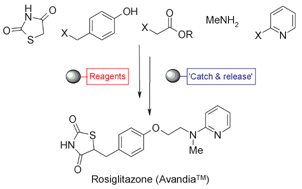
Org. Biomol. Chem., 2003,1, 4392-4395
https://doi.org/10.1039/B307549D
Design, synthesis and evaluation of bifunctional inhibitors of type II dehydroquinase
The separate binding features of glycerol and a known inhibitor were combined in the design of a series of novel inhibitors of type II dehydroquinase.
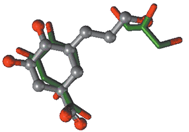
Org. Biomol. Chem., 2003,1, 2075-2083
https://doi.org/10.1039/B301731A
A simple method for the preparation of 3-hydroxyiminodehydroquinate, a potent inhibitor of type II dehydroquinase

J. Chem. Soc., Perkin Trans. 1, 2002, 2065-2068
https://doi.org/10.1039/B206066C
Synthesis of 4-deoxyquinic, 4-deoxyshikimic and 4-deoxy-3-dehydroshikimic acids
Comparative study of the protection of modified and unmodified dsDNA by cationic and non-cationic lipids and liposomes to digestion by DNase I
Synthesis of (2R)-2-bromodehydroquinic acid and
(2R)-2-fluorodehydroquinic
acid

Synthesis of tetrahydroquinolines, hexahydrobenzoindolizines and an aryl phosphonate linker for the generation of catalytic antibodies
Comparison of the substrate specificity of type I and type II dehydroquinases with 5-deoxy- and 4,5-dideoxy-dehydroquinic acid
Design and synthesis of transition-state analogues for a cationic cyclisation
Different mechanistic and stereochemical courses for the reactions catalysed by type I and type II dehydroquinases
Studies on the biosynthesis of hydroxymellein using 17O n.m.r. and 2H n.m.r. spectroscopy to determine the origin of the C-4 hydroxy group
Biomimetic syntheses of the polyketide fungal metabolites alternariol and rubrofusarin: models for cyclisation reactions catalysed by polyketide synthase enzymes
Biosynthesis of 6-methylsalicylic acid; the combined use of mono- and tri-duteriated acetate precursors to investigate the degree of stereocontrol in the aromatisation sequence
Biosynthesis of the polyketide mellein from CD3CO2H and 13CD3CO2H in Aspergillus melleus: detection of deuterium by 2H n.m.r. and edited 13C n.m.r. spectra
Biosynthesis of the fungal metabolites alternariol, mellein, rubrofusarin, and 6-methylsalicylic acid from CD3CO2H
The use of 2H n.m.r. spectroscopy and β-isotopic shifts in the 13C n.m.r. spectrum to measure deuterium retention in the biosynthesis of the polyketide 6-methylsalicylic acid
Quantitative tracking of the growth of individual algal cells in microdroplet compartments
The work establishes the methodology to encapsulate, grow, and monitor single algal cells in microdroplets of aqueous medium suspended in fluorinated oil for extended periods of time.

Integr. Biol., 2011,3, 1043-1051
https://doi.org/10.1039/C1IB00033K